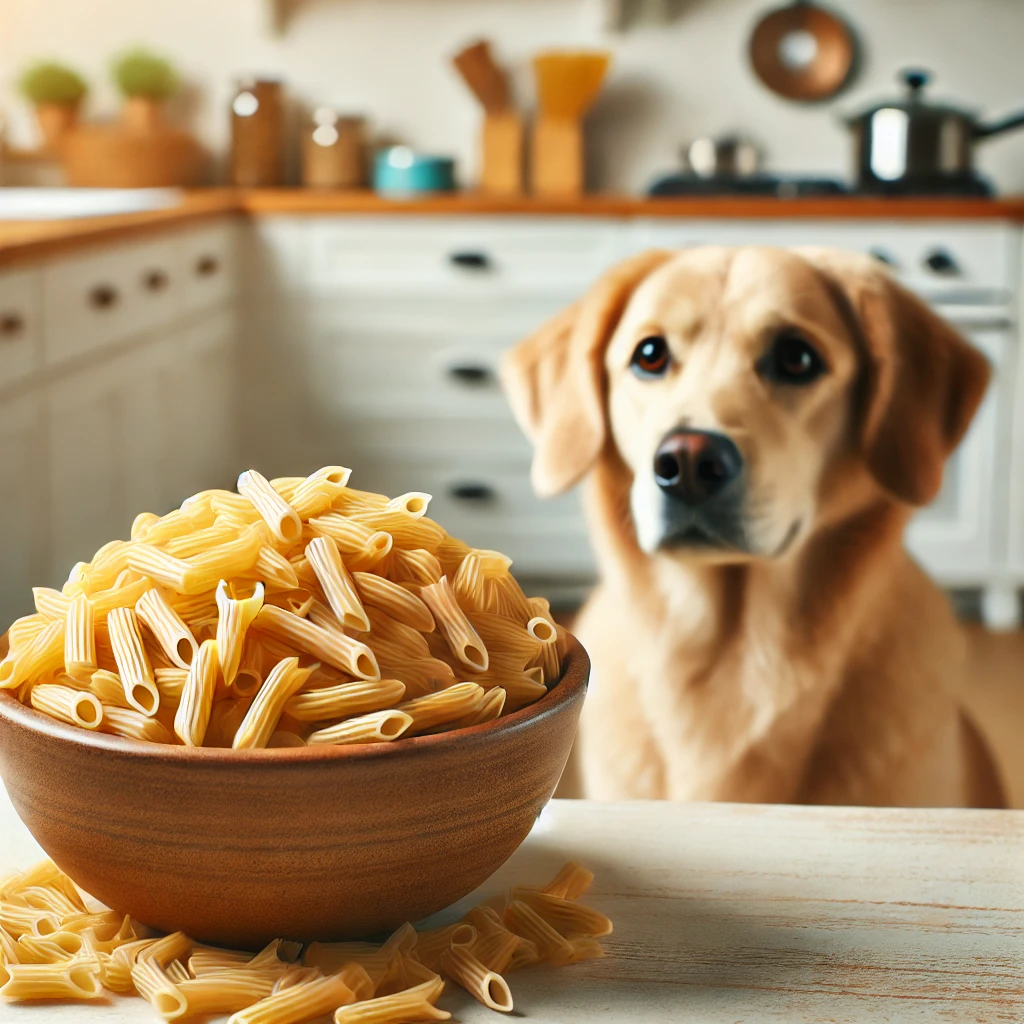
If you’ve ever enjoyed a bowl of spaghetti with your dog giving you those longing eyes, you may have wondered, “Can dogs eat pasta?”
While pasta is a staple in many households, feeding it to your furry friend requires some consideration.
Let’s dig into whether pasta is safe for dogs, what types are better suited for your pet, and how you can serve it safely.
Pasta’s Basic Composition and Its Impact on Dogs
Pasta is a popular food enjoyed by millions worldwide and is typically made from simple ingredients: wheat flour, water, and sometimes eggs.
While these ingredients may seem harmless, it is essential to understand their impact on dogs’ health and why moderation is crucial when sharing pasta with your furry friend.
1. Carbohydrates as a Major Component
- Pasta is primarily made up of carbohydrates, which serve as a source of quick energy. While carbohydrates are not inherently harmful to dogs, they are not an essential part of a canine’s diet. Dogs primarily thrive on proteins and fats, with carbohydrates playing a less significant role.
- Impact on Dogs: Too many carbs can lead to weight gain, sluggishness, and even obesity in dogs if not balanced with adequate exercise and a well-rounded diet. For dogs with a sedentary lifestyle, excess carbs may contribute to unwanted pounds.
2. Wheat Flour and Gluten Sensitivity
- Most pasta contains wheat flour, a common source of gluten. While gluten is safe for most dogs, it can trigger allergies or sensitivities in some, leading to digestive issues such as gas, bloating, diarrhea, or itchy skin.
- Impact on Dogs: For dogs with gluten sensitivity or intolerance, consuming traditional pasta can lead to discomfort and potential long-term health concerns. Opting for gluten-free alternatives like Brown Rice Pasta or Quinoa Pasta can provide safer options.
3. Egg Content and Protein
- Some types of pasta, such as egg noodles, include eggs as a primary ingredient. Eggs are generally nutritious for dogs and can be a good source of protein. However, the amount of eggs in pasta is often minimal and does not significantly contribute to your dog’s protein intake.
- Impact on Dogs: While eggs are not typically a concern, it is worth noting that some dogs may have egg allergies. If your dog is allergic to eggs, ensure that any pasta given is egg-free.
4. Additives, Salt, and Other Ingredients
- Store-bought pasta may contain added salt, preservatives, and flavorings. Salt in excess can be harmful to dogs, potentially leading to dehydration, electrolyte imbalance, or even sodium poisoning in extreme cases.
- Impact on Dogs: It is best to serve plain, unseasoned pasta to avoid any potential health risks associated with these additives. Homemade pasta, without salt or other unnecessary ingredients, can be a safer option.
5. Digestibility Considerations
- Dogs have different digestive systems than humans and are not as well-equipped to process large amounts of starchy foods. Too much pasta can lead to indigestion, bloating, and changes in stool consistency.
- Impact on Dogs: To minimize digestive issues, it is advisable to serve pasta in small amounts as an occasional treat, making sure it is fully cooked to ease digestion. Undercooked or raw pasta can be harder for dogs to break down and should be avoided.
6. Caloric Density and Weight Management
- Pasta is relatively calorie-dense and can contribute to a dog’s daily caloric intake quickly. If you regularly feed your dog pasta, it may lead to caloric imbalances, especially if not adjusted within their total diet.
- Impact on Dogs: For dogs on weight management plans or prone to obesity, limiting treats like pasta is important to maintain their health.
Healthier Alternatives to Traditional Pasta

- Whole Wheat Pasta: Offers more fiber, but watch for potential sensitivities.
- Gluten-Free Options: Consider pasta made from lentils, chickpeas, or rice for dogs with gluten sensitivities.
Product Highlight: Use a Pet-Friendly Food Processor to create healthy, dog-safe pasta mixes at home.
Understanding the composition of pasta is crucial for making informed decisions about feeding it to your dog.
While pasta can be a fun treat, ensuring it is served safely and in moderation is key to keeping your furry friend healthy and happy.
- Product Highlight: If your dog has a gluten sensitivity, consider Gluten-Free Pasta for safer consumption options.
Benefits of Pasta for Dogs (If Any)
In small amounts, plain pasta can be a good treat and source of energy for dogs.
However, it should not replace their regular balanced diet.
The carbohydrates can offer a quick burst of energy but must be consumed sparingly.
- Product Highlight: For dog-friendly carbohydrate sources, you might also try incorporating Blue Buffalo Life Protection Formula Dog Food with balanced carbs and protein.
Risks and Health Concerns of Feeding Pasta to Dogs
Feeding pasta to dogs can seem harmless, especially when shared as a small treat.
However, there are several risks and health concerns that dog owners should be aware of to ensure the safety and well-being of their furry companions.
Here is a detailed look at the potential issues to consider:
1. Carbohydrate Overload and Weight Gain
- The Issue: Pasta is high in carbohydrates, and while these can be a source of energy, excess carbohydrate consumption can lead to weight gain, especially for dogs with a sedentary lifestyle or a predisposition to obesity.
- Impact on Dogs: Overfeeding pasta can contribute to unhealthy weight gain, putting stress on a dog’s joints and potentially leading to other health problems like diabetes or cardiovascular issues.
- Recommendation: Treat pasta as an occasional snack rather than a dietary staple. Ensure it is part of a balanced diet with appropriate exercise.
2. Gluten Sensitivity or Allergies
- The Issue: Traditional pasta contains gluten, which can trigger allergic reactions or sensitivities in some dogs. Symptoms may include gastrointestinal distress (vomiting, diarrhea), skin issues (itchiness, rashes), and lethargy.
- Impact on Dogs: Dogs with gluten intolerance may experience chronic digestive problems or skin irritations if fed foods containing gluten regularly.
- Recommendation: For dogs suspected of having gluten sensitivity, consider gluten-free pasta alternatives made from ingredients like rice, lentils, or chickpeas. Monitor your dog’s reaction to new foods closely.
3. High Sodium Content in Store-Bought Pasta
- The Issue: Many commercially prepared pasta options may contain added salt. High levels of sodium can lead to dehydration, electrolyte imbalances, and, in severe cases, sodium poisoning.
- Impact on Dogs: Dogs consuming too much salt may exhibit symptoms like excessive thirst, vomiting, diarrhea, or even seizures.
- Recommendation: Always choose plain, unsalted pasta if you plan to share with your dog. Homemade pasta can be prepared without salt to ensure its safety.
4. Presence of Sauces and Harmful Additives
- The Issue: Many pasta dishes are served with sauces that contain ingredients toxic to dogs, such as garlic, onions, and certain spices. Even a small amount of these ingredients can be harmful to your pet.
- Impact on Dogs: Garlic and onions can damage a dog’s red blood cells, leading to anemia. Symptoms may include weakness, vomiting, or rapid heart rate.
- Recommendation: Serve plain pasta only. Avoid any sauces, seasonings, or toppings that may be dangerous for your dog.
5. Digestive Upset and Bloating
- The Issue: Dogs have a digestive system that differs from humans, making them less adept at breaking down starchy foods like pasta. Large amounts of pasta can lead to indigestion, bloating, or discomfort.
- Impact on Dogs: Bloating can be a serious condition, particularly in large or deep-chested dogs, and may even be life-threatening if untreated.
- Recommendation: Feed pasta in small quantities and observe your dog’s reaction. Ensure it is thoroughly cooked to aid in digestion.
6. Risk of Obstruction
- The Issue: Long pasta shapes, like spaghetti, may pose a choking hazard or lead to intestinal blockages if swallowed in large chunks or without proper chewing.
- Impact on Dogs: This can result in choking, difficulty breathing, or digestive obstruction that may require immediate medical intervention.
- Recommendation: Cut long pasta into smaller pieces before serving to reduce choking risks.
7. Imbalance in Nutrient Intake
- The Issue: Regularly feeding pasta can upset the nutritional balance in your dog’s diet. Dogs require a diet primarily rich in protein and fats, and too much pasta may dilute essential nutrients.
- Impact on Dogs: An imbalance can lead to deficiencies, affecting overall health, coat quality, and energy levels.
- Recommendation: Use pasta as a rare treat and focus on providing a nutritionally complete diet formulated for dogs.
8. Potential for Food Allergies
- The Issue: Some dogs may develop allergies to wheat or eggs commonly found in pasta. Symptoms can range from skin irritations to gastrointestinal distress.
- Impact on Dogs: Chronic exposure to allergens can lead to long-term discomfort and health issues.
- Recommendation: If you suspect an allergy, eliminate pasta from their diet and consult with your veterinarian.
9. Caloric Density
- The Issue: Pasta is calorie-dense, which can quickly increase a dog’s daily caloric intake and lead to weight management issues.
- Impact on Dogs: Excess caloric intake can contribute to obesity-related conditions like joint problems and metabolic disorders.
- Recommendation: Monitor the portion size of pasta given and ensure it fits within their overall caloric needs.
Product Highlight: For managing weight and dietary sensitivities, try Hill’s Prescription Diet Weight Management Dog Food or Zesty Paws Allergy Immune Supplement for Dogs to support your pet’s health.
By being aware of these risks and taking appropriate precautions, you can ensure that sharing pasta with your furry friend is safe and enjoyable.
Always prioritize moderation and monitor your dog’s health and behavior closely when introducing new foods.
Safe Ways to Serve Pasta to Dogs

If you choose to give pasta to your dog, it should be plain, fully cooked, and free of salt, butter, or sauces.
Here are some ideas:
- Plain Spaghetti – Cut into short pieces to prevent choking hazards.
- Cooked Noodles – Ensure they’re soft and easy for your dog to chew.
- Product Highlight: Use Ozeri Stainless Steel Dog Bowls for easy feeding and cleaning.
Pasta Types to Consider (From Spaghetti to Noodles)
Let’s explore different types of pasta and their suitability for dogs:
- Whole Wheat Pasta: Contains more fiber, but ensure your dog isn’t sensitive to wheat.
- Rice Noodles: These are often gluten-free and a safer option.
- Egg Noodles: Be cautious of added ingredients. Use plain versions only.
- Product Highlight: To test different pasta types, you can use Set of BPA-Free Dog Food Containers to store and portion meals safely.
Portion Sizes and Moderation Tips
Feeding pasta to your dog requires moderation.
Here’s how to determine serving sizes based on weight:
- Small dogs: A tablespoon of pasta as an occasional treat.
- Large dogs: Up to 1/4 cup.
- Product Highlight: Use a Digital Pet Food Scale to measure out portions accurately.
Signs Your Dog May Have Eaten Too Much Pasta

While pasta can be a tasty treat for dogs in small amounts, excessive consumption can lead to several concerning symptoms and potential health issues.
Being able to recognize the signs that your dog has eaten too much pasta is crucial for addressing problems quickly and ensuring your furry friend’s well-being.
1. Digestive Upset
- Symptoms: Vomiting, diarrhea, gas, or bloating.
- Explanation: Dogs may struggle to digest large amounts of carbohydrates, especially if their regular diet is low in grains or starches. This can lead to gastrointestinal distress, making your dog uncomfortable or lethargic.
- What to Do: If your dog exhibits any signs of digestive upset, monitor their water intake to prevent dehydration and consider offering plain boiled rice or pumpkin to soothe their stomach. If symptoms persist, contact your veterinarian.
2. Bloating and Abdominal Distension
- Symptoms: A visibly swollen stomach, panting, restlessness, pacing, or signs of discomfort.
- Explanation: Consuming too much pasta can cause bloating, which may lead to a potentially life-threatening condition called gastric dilatation-volvulus (GDV), particularly in large or deep-chested dogs. In this condition, the stomach can twist and require emergency medical attention.
- What to Do: If you suspect severe bloating or notice signs of GDV (such as retching without vomiting or an overly hard stomach), seek immediate veterinary care.
3. Lethargy and Fatigue
- Symptoms: Lack of energy, sluggish behavior, or excessive sleeping.
- Explanation: A sudden intake of carbohydrates can lead to a spike and subsequent drop in blood sugar levels, causing fatigue and sluggishness. Additionally, excessive digestion demands may leave your dog feeling tired.
- What to Do: Encourage rest, monitor your dog’s behavior over the next few hours, and consult a vet if lethargy continues or worsens.
4. Excessive Thirst and Urination
- Symptoms: Increased drinking and more frequent trips outside to urinate.
- Explanation: High salt content in certain pasta recipes or excessive carbohydrate intake can cause your dog to become dehydrated, prompting increased thirst. Elevated carbohydrate consumption can also affect blood sugar levels, leading to temporary imbalances.
- What to Do: Ensure your dog has access to plenty of fresh water and monitor their intake and urination patterns. If the excessive thirst persists, reach out to a veterinarian.
5. Weight Gain Over Time
- Symptoms: Noticeable weight gain, decreased mobility, or difficulty exercising.
- Explanation: Regularly consuming large amounts of pasta can lead to weight gain due to its high-calorie content. Excessive carbohydrates contribute to fat storage if not burned off through activity.
- What to Do: Adjust your dog’s diet and exercise regimen to promote weight loss. Consider consulting a veterinarian or a pet nutritionist for guidance on portion control and appropriate exercise routines.
6. Allergic Reactions (If Sensitive to Ingredients)
- Symptoms: Itchy skin, hives, redness, ear infections, or gastrointestinal distress (vomiting, diarrhea).
- Explanation: If your dog has an allergy to ingredients commonly found in pasta, such as wheat or eggs, consuming too much can trigger allergic reactions or worsen existing sensitivities.
- What to Do: Discontinue feeding pasta and contact a veterinarian for allergy testing or treatment options, which may include dietary adjustments or antihistamines.
7. Obstruction Risks (Particularly with Long Pasta)
- Symptoms: Choking, coughing, pawing at the mouth, vomiting, or signs of distress while eating or afterward.
- Explanation: Long pasta shapes like spaghetti can become lodged in the throat or cause choking, especially if consumed too quickly. Large, unchewed pieces may also lead to partial obstructions in the intestines.
- What to Do: If choking occurs, try to clear the blockage if it is safe to do so. If your dog appears to be struggling to breathe or is showing signs of intestinal blockage (vomiting, lack of appetite, constipation), contact a veterinarian immediately.
8. Hyperactivity or Behavioral Changes
- Symptoms: Restlessness, sudden bursts of energy, pacing, or difficulty settling down.
- Explanation: A spike in carbohydrates may temporarily elevate your dog’s blood sugar levels, leading to hyperactive behavior or mood swings.
- What to Do: Give your dog space to burn off the excess energy safely, but monitor their behavior closely. If hyperactivity becomes erratic or leads to anxiety-like symptoms, a vet’s input may be necessary.
9. Dental Issues Over Time
- Symptoms: Bad breath, plaque buildup, gum redness, or visible tooth decay.
- Explanation: Starchy foods like pasta can contribute to plaque buildup and dental problems if fed regularly, especially if not followed by dental care.
- What to Do: Brush your dog’s teeth regularly with Dog-Friendly Toothpaste and consider dental chews to maintain oral health.

Final Thoughts
If you suspect your dog has eaten too much pasta and is displaying any of these signs, it’s crucial to respond promptly.
While pasta is not inherently toxic, overconsumption can have serious consequences, especially when combined with inappropriate ingredients or toppings.
Always prioritize moderation, and when in doubt, consult with a veterinarian for advice tailored to your pet’s specific needs.
Expert Opinions or Vet Advice
According to veterinarians, pasta should only be given occasionally and in moderation.
It’s not a replacement for regular dog food.
- Product Highlight: For a vet-approved diet plan, try Hill’s Science Diet Dry Dog Food as a staple.
Frequently Asked Questions
- Can dogs eat pasta with sauce?
No, sauces often contain ingredients that are toxic to dogs, such as garlic and onions. - Is gluten-free pasta better for dogs?
Yes, if your dog is sensitive to gluten, gluten-free pasta is a better alternative.
- Product Highlight: Consider adding Dog Allergy Supplements to support digestive health if you suspect sensitivity.
Engaging Conclusion
In conclusion, “Can dogs eat pasta?”
Yes, but it’s all about moderation and ensuring the pasta is plain, cooked, and free from harmful ingredients.
Remember to treat pasta as an occasional snack and focus on providing a balanced, vet-approved diet.
Additional Resources
- Check out our posts on How to Make Homemade Dog Food (Recipes Included!): Tips from Pet Nutritionists and Can Dogs Eat Brown Rice? A Guide to Adding It to Their Meals for more dietary insights.
As an Amazon Associate, I earn from qualifying purchases.


